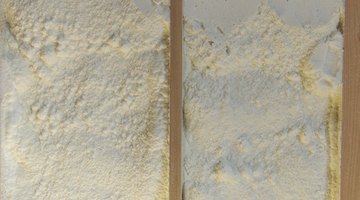What Are the Dangers of Polyurethane Resin Dust?
Polyurethane resin is used in residential and commercial insulation; it is also widely used in the production of model-making for hobbyists and in special-effects shops for film and television. In a liquid form, polyurethane resin can be molded to the desired shape, and then sanded smooth after hardening.

Sanding, however, creates dust that can be dangerous if not handled correctly.
Polyurethane Resin
Polyurethane resin is a type of polymer that results from the chemical reaction when an organic isocyanate is combined with a compound containing a hydroxl — which are components of bases, acids, phenols and amphoteric compounds. The chief health hazard associated with polyurethane resin is the presence of isocyanates; these are highly toxic and can have adverse health effects if proper precautions are not taken when working with the product. (See ref 4)
Health Risks
When polyurethane resin dries, it often requires sanding, which produces a fine dust. Exposure may cause severe eye irritation, and skin may experience redness, swelling and blistering if exposed to the dust for an extended period. Polyurethane resin dust also poses danger when inhaled, and can irritate the respiratory tract or contribute to rhinitis and asthma, according to the European Agency for Health and Safety at Work. (See Ref 3, page 66)
Scientific Study
A 1975 study published in the Journal of Environmental Health Perspectives and jointly funded by the Society of Plastics Industry and the Center for the Study of the Human Environment details the results of an experiment in which rats were exposed to particles of polyurethane resin via intratracheal intubation. Initial responses were inflammation and macrophage activity, with the appearance of fibrosis at about six months. Nodular scars and perifocal emphysema appeared at about one year. At 18 months, four of the rats were suffering from papillary adenoma in a major bronchus. (See Ref 1)
Safety
Risk of inhalation can be mitigated by taking certain precautions. When sanding polyurethane resin, use wet sandpaper to reduce the amount of airborne dust, and always wear a filter mask and safety goggles. Gloves and a long-sleeved shirt are also a good idea to reduce skin exposure. The room in which you are working should be well-ventilated. If you begin experiencing any adverse reactions while sanding polyurethane resin, you should contact a physician immediately. (See Ref 2)
The Drip Cap
- Polyurethane resin is used in residential and commercial insulation; it is also widely used in the production of model-making for hobbyists and in special-effects shops for film and television.
- See ref 4) When polyurethane resin dries, it often requires sanding, which produces a fine dust.
- Nodular scars and perifocal emphysema appeared at about one year.
References
- Journal of Environmental Health Perspectives: Pulmonary Response to Polyurethane Dust
- West System: How to Prevent Overexposure to Epoxy
- European Agency for Health and Safety in the Workplace: Expert Forecast on Emerging Chemical Risks Related to Occupational Safety and Health
- U.S. Occupational Safety & Health Administration: Isocyanates
Resources
Photo Credits
- fz750/iStock/Getty Images
- fz750/iStock/Getty Images
More Articles



